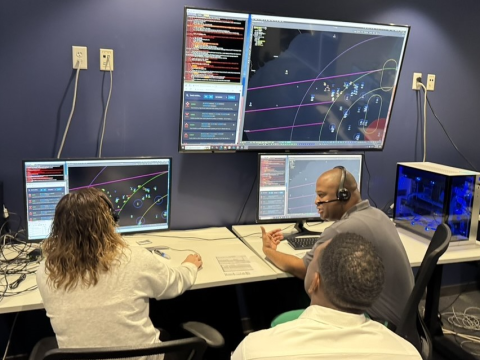Filtering the Fog of War
 |
The single spiral image is an off-angle scanning electron microscope image of a fabricated circular polarizer. A circular polarizing camera could help warfighters filter out unwanted light. |
Light filtering technology developed with funding from the U.S. Air Force Office of Scientific Research may one day allow warfighters to see more clearly through clouds, dust or other obscurants. The technology could lead to a circular polarization camera capable of improving intelligence, surveillance and reconnaissance technologies that would boost situational awareness on the battlefield or for homeland defense. It also could aid cancer detection and even enhance 3-D movies.
Circular polarization can be used with any camera, including full-motion video cameras mounted on unmanned aerial vehicles, or with infrared cameras used for surveillance or targeting systems. By measuring light in a different way than conventional cameras, the technology will offer a clearer view, providing warfighters or first responders with more accurate information for decision making.
Light waves reflected off of objects or traveling through dust or clouds oscillate in different directions. The frequency of the oscillation is related to the color of the light. The direction of oscillation is related to the property of polarization. Polarization can be either linear or circular.
The new filtering technology allows users to measure the polarization state of light quickly and efficiently, offering up a wealth of knowledge and an array of potential applications. It is, by far, the easiest circular polarization filter to fabricate, according to the scientists who developed it. For homeland security or battlefield missions, it could be especially useful for locating otherwise hard-to-find manmade objects. Looking at different wavelengths—color in the visible spectrum, infrared and thermal—provides different amounts of contrast for different scenes, explains Russell Hollingsworth, senior scientist at ITN Energy Systems Incorporated, Littleton, Colorado, the prime contractor on the now-complete Air Force Office of Scientific Research (AFOSR) project.
“Objects that are nearly invisible in one wavelength band can be easily visible in another, Hollingsworth notes. “Polarization imaging provides another way to increase the contrast because manmade objects typically have a much different polarization response compared to natural objects.”
Hollingsworth compares light waves to the mechanical waves of a rope that can be forced to oscillate up and down or sideways. With the rope stretched between pickets of a fence, up and down waves of the rope could pass; sideways movements would not. “An optical polarizer works the same way. You can produce a circularly polarized wave on a rope by moving your hand in a circle, instead of along a line, which produced the linearly polarized wave,” Hollingsworth says. “Rotating your hand either clockwise or counterclockwise produces the two types of circularly polarized wave. Light waves have the same properties of both linear and circular polarization.”
Linear polarization filters are easy to make and are common. Circular polarization filters, on the other hand, have been much more difficult—until now. Researchers at ITN and the Colorado School of Mines (CSM), Golden, Colorado, accomplished a major breakthrough when they developed a microstructure that accurately measures polarization, the key to making a true circular polarization camera. The bottom layer of the microstructure is a metal plate with a tiny hole surrounded by a set of grooves—straight for a linear polarizer or spiral for a circular polarizer. This plate is covered by a thin, transparent layer of silicon dioxide, also known as glass. The top is a metal cap that covers only the hole in the bottom metal. “We use gold for both metal layers,” Hollingsworth reports. “All of the dimensions are comparable to the wavelength of light.”
He adds that the gratings on the structure act like mirrors. “These mirrors are special in that they reflect different polarizations differently. One polarization is focused through the aperture, while the other is focused away from the aperture, so the gratings filter out the second polarization,” he says.
 |
On the right, a simulated polarization-sensitive focal plane array includes three linear polarizers with different orientations and a spiral circular polarizer in a group of four pixels, which is then repeated to form a large array. The images on the left simulate the power flow from the finite element models. |
The basic scientific research is complete, and the technology is ready to transfer from the AFOSR. ITN and CSM are searching for commercial or military partners to fund further development. “The next major milestone will be to fabricate a large-format focal plane array with integrated micropolarizers and put it into a camera,” Hollingsworth says. He adds that digital color cameras use red, green and blue color filters over individual pixels of the focal plane array sensor. The color information is fused in software to generate a full-color image. The polarization state of light can be determined with four measurements. For example, this would include three pixels with linear polarizers oriented vertically, horizontally and at 45 degrees plus one pixel with a circular polarizer. “The four measurements would then be fused in software to generate a polarization image,” he says. “A prototype camera would take one to two years to demonstrate.”
In addition to its potential for homeland security or military missions, the technology also could prove useful for detecting cancer. “It’s been found that cancer cells have a different polarization response than normal cells, and that polarization imaging is more sensitive than color imaging for determining the cancerous boundary in skin cancer. That allows surgeons to minimize the amount of healthy tissue that is removed while still ensuring that all of the cancer is removed,” Hollingsworth explains.
He adds that a lot of biological molecules have a spiral shape. DNA, for example, is a double helix, and many sugars, proteins and other amino acids, have a helical shape. They have biologically active molecules that spiral either to the right or the left. Looking at the circular polarization shows whether the molecule is “left-handed” or “right-handed” in its spiral. “In developing or purifying drugs, that would allow you to sort the molecules you want. In looking for skin cancers, you see a normal response and distinguish where the cancerous cells are located,” he says.
Polarization filtering also might benefit the movie industry. Hollingsworth theorizes that a metamaterial—a synthetic material with special properties—could act just like a high-efficiency circular polarization filter. “This is exactly what you need for state-of-the-art 3-D movie glasses. The ones that are currently used have a combination of a linear polarizer and something called a wave plate. The wave plate converts circular polarization into linear polarization, and then the linear polarizer filters out one of the now-linear polarization states. A film of these structures could offer an alternative to the current approach,” Hollingsworth says, adding that research is still underway.
WEB RESOURCES
ITN Energy Systems: www.itnes.com/index.html
Colorado School of Mines: www.mines.edu/
Air Force Office of Scientific Research: www.wpafb.af.mil/news/story.asp?id=123288910




Comments